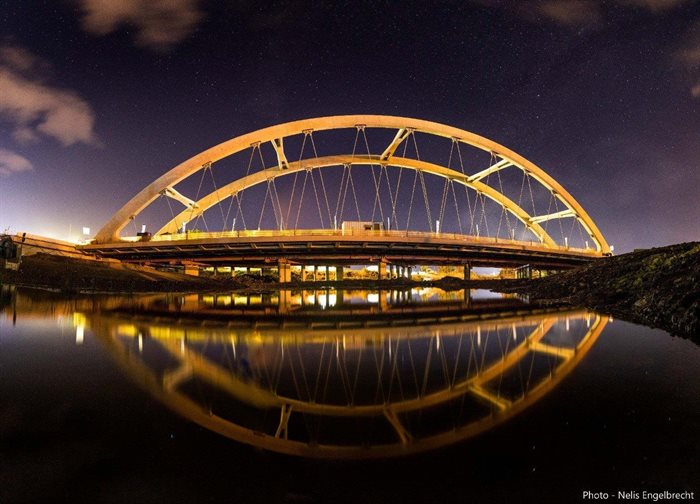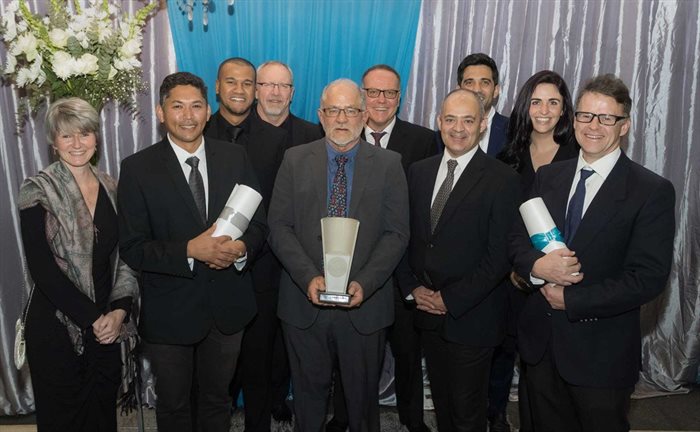
Held every two years by Cement & Concrete South Africa (CCSA), the Fulton Awards recognises excellence in the design, use, and innovation in concrete.
Aecom, which entered the project on behalf of its client, the Western Cape Government’s Department of Transport and Public Works, Roads Branch, was responsible for all engineering aspects, from road and bridge design to project and construction management. The main contractor was Haw & Inglis Civil Engineering.
“The successful completion of this project clearly shows that innovative design and construction techniques are able to blend structural concrete and steel, using modern structural methodology, into one unified end product with a distinct purpose and aesthetic appeal. It has been a great privilege to be part of this project team and work closely with all involved,” says Aecom Cape Town bridges team lead Abé Newmark.
“It has definitely been the most memorable project experience of my 40-year career as a bridge engineer.”
Aecom concrete specialist Philip Ronné, associate engineer – bridge engineering, cites the success of the bridge due to the management of the interface between bridge engineering and construction materials. Careful attention was paid to the materials selection and structural performance to ensure constructability of the larger concrete elements, while favouring important environment, sustainability and governance (ESG) goals like recycling. In this regard, the old bridge became part of the foundation of the new bridge.

In terms of sustainability, the cementitious system adopted comprised 30% fly ash, which has a much lower embodied carbon content. The specific stone used in the concrete mix was selected carefully. This relates to the structure’s response to the evolution of heat that the concrete experiences as it hardens, which can cause cracking during cooling to an ambient temperature.
To counter this, the stone aggregate, with favourable coefficient of thermal expansion property, was selected to minimise such movement. Together with careful binder selection, Ronné came up with a 50MPa high-strength concrete mix with the required structural performance, long-term durability, and lowest heat signature.
Ronné even spent time at the batching plant during the critical large concrete pours to ensure quality control.
“If there is any problem once cast, it has to be demolished, so you can imagine the importance of getting it right the first time in terms of time and other considerations,” notes Newmark.
During the casting process itself, Aecom was able to use its expertise to assist the main contractor, especially regarding the convergence of a high number of post-tensioning anchors, steel reinforcement and hanger anchors at the arch spring points.
Another key consideration was the time-dependent properties of the concrete mix to predict how the structure behaves over its entire life cycle. Here the first 30 years is the most critical because as the structure deforms continuously over time due to creep and shrinkage, this impacts the structural behaviour. The cable tensioning was calibrated to ensure that behaviour was modelled with sophisticated bridge modelling software.
There were four tensioning phases, with the initial tensioning of the bridge structure taking six to 12 months. Following this process, it was remodelled and tensioned again to ensure the concrete stays in an uncracked condition for at least the next 30 years.
“The other aspect that feeds into the innovation is obviously the transverse launching, a first for Africa,” Newmark notes. To minimise traffic disruption, the new bridge was constructed adjacent to the existing bridge while maintaining traffic over it. Upon completion, the new bridge was then used as a temporary bypass and river crossing while the existing bridge was demolished, and new abutments built. The new tied-arch bridge was launched transversely into its final position in less than 12 hours on 14 August 2021.

The Fulton Award and Commendation and subsequent recognition by the CCSA is an important acknowledgement of the engineering excellence inherent in the project. “The fact that we ultimately managed to deliver the project even faced with all of these obstacles was a landmark achievement,” cites Newmark.
“A project like this reveals that our South African engineers can compete with the best in the world, which is very encouraging.”